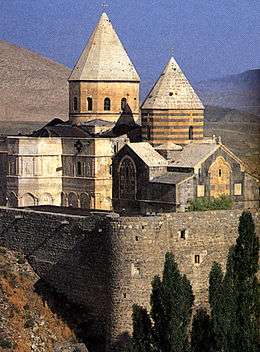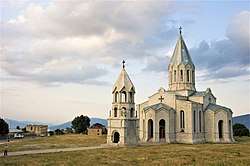Saint Mesrop Mashtots Church
Saint Mesrop Mashtots Church (Armenian: Սուրբ Մեսրոպ Մաշտոց եկեղեցի) is an Armenian Apostolic church in Oshakan that contains the grave of Mesrop Mashtots, the inventor of the Armenian alphabet. It is one of Armenia's better known churches[1] and a pilgrimage site.[2][3][4] Pilgrims visit the church on the Feast of the Holy Translators in October.[5]
| Saint Mesrop Mashtots Church | |
|---|---|
| Religion | |
| Affiliation | Armenian Apostolic Church |
| Year consecrated | October 21, 1879 (current church) |
| Location | |
| Location | Oshakan, Aragatsotn, Armenia |
| Architecture | |
| Founder | Vahan Amatuni |
| Groundbreaking | 443 (original) 1873 (current church) |
| Completed | 1879 (current church) |
Mashtots was buried at the site in 440, where a martyrium was built three years later. The current church dates to 1873–79, when an entirely new building was built on the grave of Mashtots, located under the altar. It has been the seat of the Diocese of Aragatsotn since 1996.[6][7]
Early history
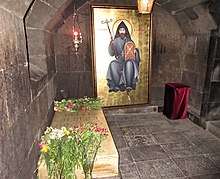
According to Movses Khorenatsi, when Mesrop Mashtots died in 440, three options were discussed for his burial place: his native Taron; Goghtn, where he had begun his missionary work; and next to the graves of other saints in Vagharshapat, Armenia's capital and seat of the Catholicos.[8][9] His body was eventually taken by Hmayeak Mamikonian, a military commander and the brother of Vardan Mamikonian,[10] and Vahan Amatuni, Armenia's Persian-appointed hazarapet (chief of finances), to Oshakan, the latter's native village.[9][11] This is attested by both Koriun, Mashtots' biographer, and Ghazar Parpetsi.[8]
According to Koriun, Vahan Amatuni built an "altar" on Mashtots' grave three years later, in 443. Hrachia Acharian interpreted it literally; he believed Amatuni simply added an altar in a pre-existing chapel.[12] The modern view is that Vahan Amatuni built a temple, i.e. a martyrium or a chapel on Mashtots' grave.[11][6][9] According to Elizabeth Redgate it was an underground martyrium.[13]
Not much is known about the history of the site until the modern period. Acharian wrote that the earliest inscription on the walls of the church dates to 1286.[14] It was left by Sahmadin, a wealthy Armenian, who apparently renovated the church. However, the inscription is now considered lost.[15] In the early 19th century, Hovhannes Shahkhatuniants recorded five inscriptions at the church, four of which were dated 1285–1295. The inscriptions are believed to have been lost during the reconstruction of the 1870s.[16]
The 17th century historian Arakel of Tabriz wrote that the roof of the "temple-mausoleum" had entirely collapsed and that only the main altar was still extant.[6] Catholicos Pilippos completely renovated the church between 1639 and 1645,[6][14] but it was heavily dilapidated by the 19th century.[17] Catholicos Nerses Ashtaraketsi made a failed attempt to renovate it in 1850.[4] Mikayel Nalbandian, a writer and activist, visited Oshakan during his only visit to Armenia in 1860 and lamented its condition in a poem.[4][6]
Reconstruction
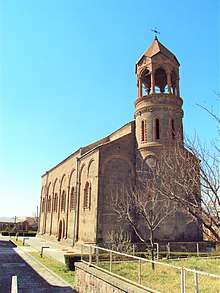
Catholicos Gevorg IV began reconstruction efforts in 1868.[4] He successfully raised funds to reconstruct the church. In 1872 he officially called upon the Armenian people to support the cause in a kondak (proclamation or encyclical).[18][19] Reconstruction works began in the spring of 1873 and were completed in 1879.[20][6] The church was built by Greek workmen from Alexandropol.[4] The new church was consecrated on October 21, 1879.[6][21] The new church is a vaulted basilica built in black tuff.[6][11][22] It has three entrances on the north, south, and west and eleven windows, not including the smaller windows on bell-tower.[22] It has a capacity of 800 people.[21] Acharian described it as a "mid-sized building, much more beautiful than usual rural churches, but lesser than churches of large cities."[20]
The grave of Mashtots is located in a cell under the main altar.[6][11] In 1884 a new marble gravestone was erected on the grave of Mashtots, inside the church, through the funds of Archbishop Andreas, primate of the Artsakh Diocese.[15] It was replaced with an Italian marble[23] gravestone in 1962 that reads: Saint Mesrop Mashtots 361-440 (ՍՈՒՐԲ ՄԵՍՐՈՊ ՄԱՇՏՈՑ 361 ✝ 440).[24][6]
A cylindrical bell-tower was added in 1884 on the eastern side of the church,[21] crowned by a rotunda with eight columns. For its location on the eastern (as opposed to the usual western end) and cylindrical design, it is a rare example in Armenian architecture.[6][11]
In 1880 a memorial was erected on the grave of Vahan Amatuni just outside the church.[6][1]
Later history
On October 13, 1912 Catholicos Gevorg V, other religious figures and common people traveled from Vagharshapat to Oshakan in a ceremonial procession as part of the celebrations of the 1,500 anniversary of the Armenian alphabet.[25]
The church underwent extensive renovation in the 1960s, during the reign of Catholicos Vazgen I, through the financial support of Hayk and Torgom Ghazarosian brothers of Milan, Italy,[26][6][27] originally from Yerznka.[28] A monument depicting the original 36 letters of the Armenian alphabet, as created by Mashtots, in the erkatagir style, was erected near the entrance to the grave of Mashtots. It was designed by Baghdasar Arzoumanian.[26] The floor of the church was covered with basalt tiles.[22] A wall with a length of 310 metres (1,020 ft) was built around the church in tuff.[22] A drinking fountain designed by Rafael Israelyan was erected at the church courtyard in 1964.[6]
The church was declared the seat of the Diocese of Aragatsotn in 1996.[6] The prelacy building was unveiled in 1997.[29]
The surrounding area of the church was renovated in 2000 by Djivan Koboyan, an Armenian American philanthropist.[6][30]
In August 2012 archaeologist Frina Babayan uncovered remains of the 5th-century structure near the foundations of the bell tower.[31]
Frescoes
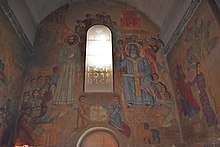
The interior of the church was covered with frescoes by Hovhannes Minasian and Henrik Mamian in 1961–64.[23] They created the monumental fresco Glory to Armenian Letters and Literature («Փառք հայ գրի և դպրության»), which depicts the invention of the Armenian alphabet.[6] Major figures associated with Mashtots are included in it: Mashtots, Catholicos Sahak Partev, King Vramshapuh and prince Vahan Amatuni.[32] Minasian also created the altarpiece, depicting the Virgin and Child, in 1966.[6] The fresco was restored in 2019 restored through funding by Armenia's President Armen Sarkissian.[33]
Dpratun
A school was established next to the church in 1913.[6] It served as a public school during the Soviet period.[22] The building was renovated in 1996-97 through the financial support of Djivan Koboyan, an Armenian American philanthropist,[6] and was reopened on October 18, 1998. It serves as a dpratun (դպրատուն), a scientific and educational center, dedicated to Mashtots and the Armenian alphabet.[34]
References
- "Ս. Մեսրոպ Մաշտոց եկեղեցի". hushardzan.am (in Armenian). Ministry of Culture of Armenia Service for the Protection of Historical Environment and Cultural Museum-Reservations. 30 April 2015. Archived from the original on 5 April 2019.
- Stopka, Krzysztof (2016). Armenia Christiana: Armenian Religious Identity and the Churches of Constantinople and Rome (4th–15th Century). Wydawnictwo Uniwersytetu Jagiellońskiego. p. 60. ISBN 9788323395553.
For centuries Armenian Christians would come to Oshakan near Yerevan to pay their respects at the graveside of Mashtots, the inventor of the Armenian script.
- Acharian 1984, p. 289.
- Teryan 1963, p. 26.
- Editorial (2008). "Սրբոց Թարգմանչաց տոնը Օշականում". Etchmiadzin (in Armenian). 64 (10): 132.
- Hasratyan, Murad. "Օշականի Ս. Մեսրոպ Մաշտոցի եկեղեցի" (in Armenian). Yerevan State University Institute of Armenian Studies. Archived from the original on 3 April 2019.
- "The Armenian Church Today > Dioceses > Armenia". armenianchurch.org. Mother See of Holy Etchmiadzin.
- Acharian 1984, p. 286.
- Teryan 1963, p. 24.
- Babayan 2014, p. 123.
- "Սբ. Մեսրոպ Մաշտոց եկեղեցի (Օշական)" (in Armenian). Diocese of Aragatsotn. Archived from the original on 3 April 2019.
- Acharian 1984, p. 288.
- Redgate, A. E. (2000). The Armenians. Oxford: Blackwell Publishing. p. 162. ISBN 9780631220374.
- Acharian 1984, p. 290.
- Teryan 1963, p. 25.
- Muradyan, Paruyr (2000). "Օշականի 1286 թ. արձանագրության «Քեթոբար» վարչական տերմինը". Etchmiadzin (in Armenian). Mother See of Holy Etchmiadzin. 56 (2): 88–92.
- Teryan 1963, pp. 25-26.
- Morikeants, Georg Harutiunian (1871). "Օշական". Ararat (in Armenian). Mother See of Holy Etchmiadzin. 4 (1): 59.
- Editorial (1872). "Դամբարան եւ եկեղեցի սուրբ Մեսրովբ թարգմանչի յՕշական". Ararat (in Armenian). Mother See of Holy Etchmiadzin. 5 (7): 285–286.
- Acharian 1984, p. 291.
- Teryan 1963, p. 27.
- Teryan 1963, p. 28.
- Khanjyan 1968, p. 17.
- Teryan 1963, pp. 28-29.
- H., Av. (1912). "Տառերի գիւտի 1500-սւմեայ եւ տպագրութեան 400-ամեայ Մեծ յօբելեանի բացման հանդէսը Ս. էջմիածնում եւ Օշականում". Ararat (in Armenian). 46 (10–11): 896–909.
- Teryan 1963, p. 29.
- Editorial (1961). "Օշականի Սուրբ Մեսրոպ Մաշտոց եկեղեցու վերանորոգությունը". Etchmiadzin (in Armenian). Mother See of Holy Etchmiadzin. 11 (1): 37–39.
- Khanjyan 1968, p. 13.
- Editorial (1997). "Թարգմանչաց տոնին Օշականում բացվեց առաջնորդարանի նոր շենքը". Etchmiadzin (in Armenian). 53 (10): 34–36.
- Editorial (2000). "Ցնծության օր Արագածոտնի թեմում". Etchmiadzin (in Armenian). Mother See of Holy Etchmiadzin. 56 (10): 44.
- Babayan 2014, p. 127.
- Khanjyan 1968.
- "Նախագահ Արմեն Սարգսյանի աջակցությամբ վերականգնվում է Օշականի Սուրբ Մեսրոպ Մաշտոց եկեղեցու «Փառք հայ գրի և դպրության» որմնանկարը". factor.am (in Armenian). 15 November 2019. Archived from the original on 15 November 2019.
- Mkrtchian, H. (1998). "Օշականում բացվեց Սբ. Մեսրոպ Մաշտոց դպրատունը". Etchmiadzin (in Armenian). 54 (10–11): 147–149.
- Bibliography
- Acharian, Hrachia (1984). Հայոց գրերը [The Armenian Letters] (in Armenian). Yerevan: Hayastan Publishing.CS1 maint: ref=harv (link)
- Teryan, Vahan vardapet (1963). "Օշականի Սուրբ Մեսրոպ-Մաշտոց եկեղեցին". Etchmiadzin (in Armenian). Mother See of Holy Etchmiadzin. 20 (3): 22–29.CS1 maint: ref=harv (link)
- Babayan, Frina (2014). "Օշական գյուղի Ս. Մեսրոպ Մաշտոց եկեղեցու պեղումների մասին (2012 թ. օգոստոս) [On the excavations of St. Mesrop Mashtots Church in village Oshakan]". Etchmiadzin (in Armenian). Mother See of Holy Etchmiadzin. 71 (3): 122–127.CS1 maint: ref=harv (link)
- Khanjyan, Grigor (1968). "Օշականի եկեղեցու վերանորոգության առթիվ". Etchmiadzin (in Armenian). 24 (3): 13–19.CS1 maint: ref=harv (link)
- Further reading


